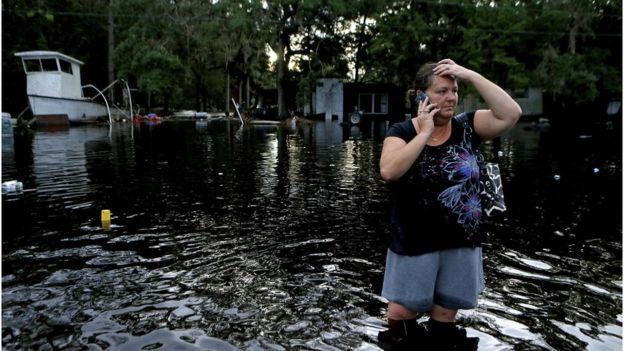 Hurricane Hermine - via BBC[/caption]
It happened. After a decade of relative calm, Florida was hit by a hurricane.
Despite only being classified as a Category 1, Hurricane Hermine did some big damage, cutting off power for over 250,000 people in Florida. Despite the widespread power loss, NBC reported nothing was life threatening as far as damage was concerned.
Flooding in Florida has turned the roads into dangers. One region received more than 9 inches of rain from Tuesday before Hermine even made landfall. After Hurricane Hermine has since weakened into a tropical storm, but major flooding – including flash floods and river floods – threaten parts of Georgia and the Carolinas.
Hurricane Hermine - via BBC[/caption]
It happened. After a decade of relative calm, Florida was hit by a hurricane.
Despite only being classified as a Category 1, Hurricane Hermine did some big damage, cutting off power for over 250,000 people in Florida. Despite the widespread power loss, NBC reported nothing was life threatening as far as damage was concerned.
Flooding in Florida has turned the roads into dangers. One region received more than 9 inches of rain from Tuesday before Hermine even made landfall. After Hurricane Hermine has since weakened into a tropical storm, but major flooding – including flash floods and river floods – threaten parts of Georgia and the Carolinas.
Even though Hurricane Hermine has been downgraded into a tropical storm, it’s still dangerous with maximum sustained winds of 60 miles per hour. CNN thinks it could even stall off the East Coast for days once it passes the Carolinas. According to Rick Knabb, hurricane center Director, “the most frequent cause of life…is from inland flooding due to heavy rainfall.” So just because there is no longer a hurricane doesn’t mean the threat is over. Be aware of the watches and warnings issued for your region. And if there is flooding, stay away. “Turn around, don’t drown” is NOAA’s slogan when it comes to floods. Remember, even just 6 inches of moving water can knock an adult off his feet, and 12 inches can carry away a car. Hurricane Hermine is expected to continue travelling up the coast and should reach Boston by Monday, if it makes it that far. This will increase the flood risk of all coastal states due to rain and storm surges. If you live along that route, make sure you have the necessary gear and supplies in case you need to weather the storm. If you’re not in that area, then now’s a great time to prepare for another disaster that could come your way without warning.Flooding in Shore Acres. Stay off the roads pic.twitter.com/Xgkqni4yNz
— St. Pete Police (@StPetePD) September 2, 2016
 Learn all about hurricanes here: Everything You Need to Know About Hurricanes
Learn all about hurricanes here: Everything You Need to Know About Hurricanes

